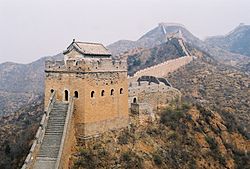Top Qs
Timeline
Chat
Perspective
Luanping County
County in Hebei, People's Republic of China From Wikipedia, the free encyclopedia
Remove ads
Luanping County (simplified Chinese: 滦平县; traditional Chinese: 灤平縣; pinyin: Luánpíng Xiàn) is a county of northeastern Hebei Province, with the Great Wall of China demarcating its border with Miyun District, Beijing to the southwest. It is under the administration of Chengde City, and as of 2020, has a population of 268,647[1] residing in an area of 3,195 km2 (1,234 sq mi). The G45 Daqing–Guangzhou Expressway, China National Highways 101 and 112, and the Beijing–Tongliao Railway pass through the county. Other bordering county-level divisions are Fengning County to the northwest, Longhua County to the north, Chengde's core districts of Shuangqiao District and Shuangluan District to the east, and Chengde County to the southeast.
Remove ads
Administrative divisions

The county administers 1 subdistrict, 10 towns, 2 townships, and 8 ethnic townships.[2]
The county's only subdistrict is Zhongxing Road Subdistrict.[2]
|
Towns:[2]
|
Townships:[2]
Ethnic Townships:[2]
|
Remove ads
Climate
Remove ads
History
In the early 15th century, the Yongle Emperor forced all residents of the Luanping area to move to within the city walls, leaving the countryside uninhabited. In the early Qing dynasty, the Kangxi Emperor ordered the now long uninhabited area to be redeveloped, with the new residents speaking a form of Mandarin Chinese that would become the predecessor of modern Standard Chinese. Simultaneously, Luanping became a stop for officials travelling between Beijing and the Chengde Mountain Resort, which contributed to residents speaking with the accent of government officials.[1]
Standard Chinese is based on the accent of Luanping residents, who speak a variety of Beijing dialect. The accent of Luanping was chosen for its more "straightforward" pronunciation compared to that of urban Beijing; for example, Beijing uses more erhua, syllable coalescence and exhibits significant dialect mixing.[1][5][6]
References
External links
Wikiwand - on
Seamless Wikipedia browsing. On steroids.
Remove ads



